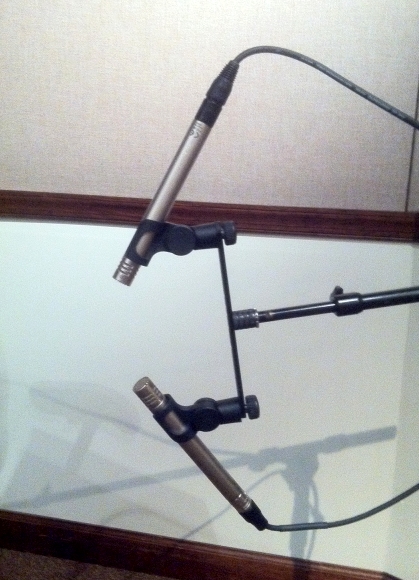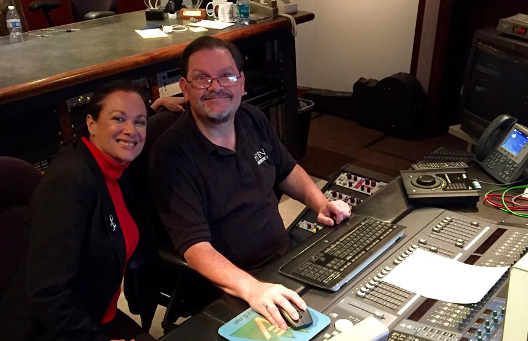The Advantages of Skill... and DNA

I was booked for another interesting job this week, a two-continent job that was fun and rewarding. This was what I called a “mushroom job” – it was bigger at the top than it was at the bottom, meaning it seemed like a small job at the beginning but grew as we went along. This one began as a five-hour session to record vocals for a national artist who was performing to a guide track, but the project grew from there. I was thinking it might be pretty run-of-the-mill but the increasing challenges involved in the production and the great people with whom I got to work broke it out of the mold.
The song was a four-minute ballad with an ensemble playing three verses and choruses, a guitar solo, and a bridge. It was written by a guitarist/composer who also executed the basic tracks at a studio in India. He then flew over to join the vocalist in the U.S. with a guitar and the tracks as .wav files on a thumb drive.
And there began the growth of the project. Firstly, as we closed on session time, the guitarist/composer asked to overdub guitar parts to the project. No problem! And secondly, the artist added that her daughter was coming into town and would be dropping in to share vocals. And that was where things became fun!
Before the session I got my DAW project started, my mics set out, and my lines checked as usual. I assembled my usual mic'ing rig for guitar that is played in an ensemble: two AKG C451B condenser mics arrayed on a stereo bar at 110 degrees and seven inches apart, in a reversal of the orientation of the ORTF array. I actually use a protractor and ruler to set the angles and distance. That array was turned on edge with the mics vertically arranged. This eliminates the voicing differences normally incurred by horizontally-arrayed stereo pairs. Thanks to George Massenberg for the inspiration.

SESSION TIME!
The vocal artist and the guitarist/composer arrived right on time. After introductions and pleasantries we loaded up the thumb drive and I got my first look at the tracks. Surprise! Instead of a stereo guitar track it was several isolate tracks of drums, piano, string pads, and bass. In order for the guitarist and vocalists to begin, we’d need at least a rough mix. Hi-ho, off to work we go!
After a quick initial mix we got down to the business of the acoustic guitar overdubs. Sure enough, our guitarist/composer was a very smooth rhythm guitarist. After getting his bearings in the phones he laid down a pair of very nice rhythm parts that I panned outboard left and right. There were a few punch-ins and a bit of comping. From there he added a track of fills to compliment the rhythm. To finish off, he took four stabs at the lead part and we chose the best parts and comped them.
Surprise number two! The drum tracks were incomplete: the kick drum and all the cymbals were corrupted. While we waited for our second vocalist to arrive I dropped into “fixer” mode, connected up a dynamic mic, quickly tapped out and sequenced kick drum and cymbal patterns, and replaced the taps with Drumagog. Ahhh! Now we were grounded.
When the vocal artist’s daughter arrived we dove into assembling the vocal tracks. The two had a basic arrangement worked out but worked on the parts as they went. Both were trained and experienced and knew how to put expression into their parts. The daughter took the first verse, the mother took the second, and they alternated lines through the third. Mom took the melody on the choruses and daughter overdubbed harmonies. Because they were doing some arrangement as they went along, they would alternate turns at the mic and deliver their parts. Ordinarily that would mean a fair amount of adjustment to the preamp and mic but because these two were amazingly matched all I had to do was adjust the gain between the two to account for a little bit of strength difference. And that’s where the DNA thing came in: We’ve seen it over and over again that family groups seem to mesh extremely well. Think of Karen and Richard Carpenter. This pair was no exception. They were able to match tonality, energy, and vibrato amazingly well and their entrances and exits meshed seamlessly. As a result of their knowledge, direction, and skills, the parts layered up effortlessly and ended up sounding lush and gorgeous. As they completed recording a harmony part I would ask them to record at least one copy so that the harmony layers could stack and could be panned outwards a bit to leave physical space for the centered lead vocals.
All the while I was tweaking the mix, adding adjustments to make the arrangement come together and adding drum bits like accent crashes and high-hat hits. The atmosphere in the control room and studio was relaxed, upbeat, and businesslike, so whenever the musicians were listening to parts or performing I was free to adjust the support tracks. I was always mixing, always mixing. I find that I really enjoy working with enthusiastic people so the time went by very quickly. We all ended up pleased with the tracks and feeling like we had all the vocals we needed to pull the production together. After a break we’ll be diving into recording drums and electric guitars and building the mix in earnest. I’m looking forward to it.

= =
=



